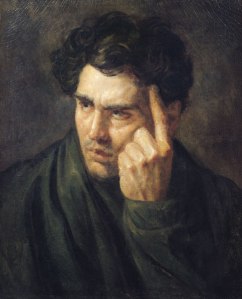Lines 915-970
The unknown third person of this passage serves as a voyeur, not into a scene or a moment but into the interior of the Giaour, directly or indirectly. It is important to focus in on the “unknown” aspect of this narrator. It is this lack of identity which allows one to insert many perspectives onto this voice. It is in this manner that ambiguity can lead to multiple readings, this is an important matter to keep in mind but this reading will not focus on that but instead will focus on the essentials of the poem which can then be reinscribed by having an identity attributed to the speaker. The lack of any mention of the Giaour, directly, also lends itself to this process. The passage is more a vignette of sentiments and analogy than an outright statement that this is in fact the Giaour, what can, however, be said is that these emotions can then be placed over or within the Giaour.
Generally speaking the passage surmises itself into the last few lines reading:
Less hideous far the tempest’s roar,
Than ne’er to brave the billows more—
Thrown, when the war of winds is o’er
A lonely wreck on fortune’s shore,
‘Mid sullen calm, and silent bay,
Unseen to drop by dull decay;—
Better to sink beneath the shock
Than moulder piecemeal on the rock
(963-970)
And a few preceding it which read:
The keenest pangs the wretched find
Are rapture to the dreary void—
The leafless desert of the mind—
The waste of feelings unemploy’d—
(957-960)
Their message is a clear one: that succumbing to the despair of losing love is the utmost tragedy, even grieving is some form of feeling which provides relief but it is the act of becoming static in emotion of despair which damns the broken hearted. This emphasis is placed in the latter passage which follows an ABAB rhyme scheme rather than the couplet form which had been followed in the rest of the passage. There is a break in the couplets which creates a space, on the page and in the spoken word, which emphasises this condition of release provided by even the subtlest of affectual winds which are referred to by the use of “billows”, the very thing which moves ships. So it is the Giaour who this ship represents, a broken love, and though it may be the case that what is made from love “must remain,/But break—before it bend again” it seems this love will not be reforged in any new love but will brittle, as Tennyson put it, (perhaps more clearly): “How dull it is to pause, to make an end,/ To rust unburnished, not to shine in use!/ As though to breathe were life! Life piled on life” (Ulysses 22-24). A question to linger on is how we might upset a reading of this by suggesting that the speaker is the Giaour himself who is ruminating, or by considering that it may be of importance to ask who knows such feelings so well that they seem to speak so truly and appropriately to the spirit of the Giaour. A text by Mishima, Yukio comes to mind, The Damask Drum from his collection of Five Modern Noh Plays which suggests that the value of the act of loving is one which is enveloped in the very act, not in the logistics of whether the love is of any particular variety or of a rare nature. It seems this spirit towards love and heartbreak runs through both works, one which suggests that respect, an utmost respect must be given to feeling things.


